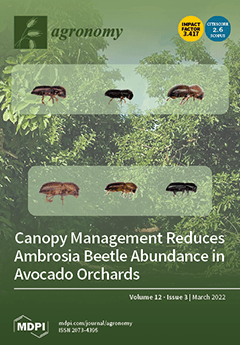Soil moisture is one of the critical factors affecting N
2O emissions. The water regime affects the physical and chemical properties of paddy soil in different soil layers, which, in turn, affects N
2O emissions and microbial growth. However, there are
[...] Read more.
Soil moisture is one of the critical factors affecting N
2O emissions. The water regime affects the physical and chemical properties of paddy soil in different soil layers, which, in turn, affects N
2O emissions and microbial growth. However, there are few reports on the effects of different soil layers and soil moisture conditions on N
2O emission characteristics and microbial mechanisms. A 21-day microcosm experiment was performed to research the effects of soil moisture levels (60%, 100%, and 200% water holding capacity, WHC) and different soil layers (0–10, 10–20, and 20–40 cm) on N
2O emissions in hydromorphic and gleyed paddy soils. Function microbes involved in nitrification and denitrification were determined by quantitative PCR. Moreover, the abiotic variables pH, Eh, and exchangeable Fe
2+, Fe
3+, NH
4+-N, and NO
3−-N were also analyzed. Results showed that N
2O emissions of gleyed paddy soil were significantly higher than that of hydromorphic paddy soil, which was consistent with the result of the abundance of nitrifier and denitrifier in the two paddy soils. Soil depth, water content, and their interaction significantly affected N
2O emission (
p < 0.05). Cumulative emissions of N
2O from each layer of the two paddy soils at 100% and 200% WHC were significantly higher than that under 60% WHC (
p < 0.05). N
2O emissions decreased significantly with the increase of soil depth (
p < 0.05), which was consistent with the change in the abundance of soil nitrifier (AOB and AOA) and denitrifier (
nirK and
nosZ) function genes with soil depth. The abundance of AOB, AOA, and
nirK and
nosZ genes decreased significantly with soil depth (
p < 0.05), but did not respond significantly to the water regime. Based on the results of redundancy analysis, the contents of Fe
2+ and Fe
3+ were positively correlated with N
2O emissions and the abundance of AOB, AOA, and
nirK and
nosZ genes. These results indicate that N
2O emissions and the abundance of associated microbes are selectively affected by soil moisture and soil layers in the two paddy soils.
Full article





